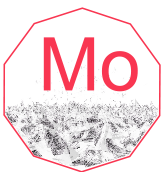Molybdenum

Molybdenum (Mo)
General Information
- Symbol: Mo
- Atomic Number: 42
- Atomic Weight: 95.95 u
- Element Category: Transition metal
- Group: 6
- Period: 5
- Block: d-block
Physical Properties
- Appearance: Silvery-gray metallic
- Density: 10.28 g/cm³
- Melting Point: 2623 °C (4753 °F)
- Boiling Point: 4639 °C (8382 °F)
- Phase at STP: Solid
- Electron Configuration: [Kr] 4d⁵ 5s¹
- Oxidation States: +6 (most common), +5, +4, +3, +2
Chemical Properties
- Reactivity: Resistant to corrosion and oxidation; reacts with acids and forms compounds with nonmetals.
- Compounds: Forms compounds such as molybdenum trioxide (MoO₃), molybdenum disulfide (MoS₂), and molybdenum carbide (Mo₂C).
Uses and Applications
- Steel Production: Used as an alloying element to improve strength, hardness, and resistance to corrosion.
- Catalysts: Molybdenum compounds are used in petroleum refining and chemical processing.
- Electronics: Utilized in thin films for transistors and photovoltaic cells.
- Aerospace: Employed in high-strength alloys and coatings due to its high melting point and strength.
- Lubricants: Molybdenum disulfide (MoS₂) is used as a high-temperature lubricant.
Occurrence and Extraction
- Natural Occurrence: Found primarily in the mineral molybdenite (MoS₂) and wulfenite (PbMoO₄).
- Extraction: Typically extracted from molybdenite through a series of steps involving roasting and leaching.
Isotopes
- Stable Isotopes: Molybdenum-92, Molybdenum-94, Molybdenum-95, Molybdenum-96, Molybdenum-97, Molybdenum-98
- Radioactive Isotope: Molybdenum-99 (used in medical imaging)
Safety and Handling
- Hazards: Generally considered to be of low toxicity, but molybdenum dust and fumes can be harmful if inhaled.
- Precautions: Handle molybdenum powder and compounds with care to avoid inhalation; use standard protective equipment in industrial settings.
History
- Discovery: Identified by Carl Wilhelm Scheele in 1778.
- Name Origin: Derived from the Greek word “molybdos,” meaning lead, due to its similarity to lead ores.
Additional Facts
- Crystal Structure: Body-centered cubic (bcc)
- Magnetic Properties: Paramagnetic
- Thermal Conductivity: High, about 138 W/m·K
- Electrical Resistivity: About 53 nΩ·m at room temperature
Summary
Molybdenum is a transition metal known for its high melting point, strength, and resistance to corrosion and oxidation. It is extensively used in steel production, catalysts, electronics, aerospace, and lubricants. Found primarily in molybdenite, it is extracted through roasting and leaching processes. Its stability and low toxicity make it valuable for various industrial and technological applications.
What is the atomic number of Molybdenum?
- 42
What is the symbol for Molybdenum?
- Mo
What is the atomic weight of Molybdenum?
- 95.95 u
In which group of the periodic table is Molybdenum found?
- Group 6
What period is Molybdenum in?
- Period 5
What block does Molybdenum belong to?
- d-block
What is the melting point of Molybdenum?
- 2623 °C (4753 °F)
What is the boiling point of Molybdenum?
- 4639 °C (8382 °F)
What is the density of Molybdenum?
- 10.28 g/cm³
What is the electron configuration of Molybdenum?
- [Kr] 4d⁵ 5s¹
What are the common oxidation states of Molybdenum?
- +6, +5, +4, +3, +2
What is the appearance of Molybdenum?
- Silvery-gray metallic
Is Molybdenum reactive with acids?
- Yes, it reacts with acids
Name a compound of Molybdenum.
- Molybdenum trioxide (MoO₃)
What is a common use of Molybdenum in the steel industry?
- As an alloying element to improve strength and resistance to corrosion
How is Molybdenum used in catalysts?
- In petroleum refining and chemical processing
What role does Molybdenum play in electronics?
- Used in thin films for transistors and photovoltaic cells
How is Molybdenum used in aerospace?
- In high-strength alloys and coatings
What lubricant uses Molybdenum?
- Molybdenum disulfide (MoS₂) as a high-temperature lubricant
Name a mineral that contains Molybdenum.
- Molybdenite (MoS₂)
How is Molybdenum extracted from molybdenite?
- Through roasting and leaching
What is the most stable isotope of Molybdenum?
- Molybdenum-98
Name a radioactive isotope of Molybdenum used in medical imaging.
- Molybdenum-99
What safety hazard is associated with Molybdenum dust?
- Can be harmful if inhaled
Who discovered Molybdenum?
- Carl Wilhelm Scheele
Where does the name Molybdenum come from?
- Derived from the Greek word “molybdos,” meaning lead
What is the crystal structure of Molybdenum?
- Body-centered cubic (bcc)
Is Molybdenum paramagnetic or diamagnetic?
- Paramagnetic
What is the thermal conductivity of Molybdenum?
- About 138 W/m·K
What is the electrical resistivity of Molybdenum at room temperature?
- About 53 nΩ·m
What is the primary oxidation state of Molybdenum?
- +6
Is Molybdenum found as a free element in nature?
- No, it is found in minerals
What is the common name of molybdenum trioxide?
- Molybdic oxide
What is a major application of Molybdenum carbide (Mo₂C)?
- Used in cutting tools
How does Molybdenum improve alloys?
- Increases strength and resistance to corrosion
What is the boiling point of Molybdenum in Kelvin?
- 4912 K
What group does Molybdenum belong to in the periodic table?
- Transition metals
What is the natural abundance of Molybdenum-98?
- About 24.14%
Can Molybdenum be used in high-temperature applications?
- Yes, due to its high melting point
What is the key property that makes Molybdenum valuable in lubricants?
- Its ability to reduce friction and withstand high temperatures.






